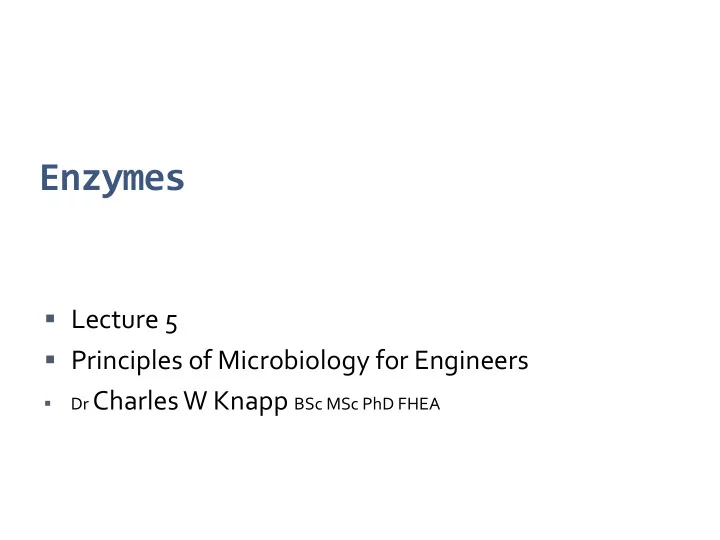

Enzymes Lecture 5 Principles of Microbiology for Engineers Dr Charles W Knapp BSc MSc PhD FHEA
Enzymes Biochemical/cellular activity Synthesis Transformation/degradation reactions Applications (e.g.): Microbial induced calcite precipitation Bio-remediation / water treatment Bio-synthesis Energy production Soil fertility
Enzymes Catalytic proteins that speed up the rate of biochemical reactions Reactants in a chemical reaction must first be activated before the reaction can take place Enzymes are highly specific in the reactions they catalyze
Enzymes Enzymes do not do anything that is thermodynamically impossible They affect rates. Net ΔG’ < 0
Enzymes The un-catalysed carboxylation of orotidine 5- monophosphate has a half-life of 78 million years With enzyme orotidine 5-phosphate decarboxylase, reaction takes 18 milliseconds
E+S ES E+P
Enzymes Protein structure (apo-protein) Active site Co-factor Organic (heme/flavin) Inorganic (metal/sulphur) Co-enzymes (vitamins, NADH/NADPH)
Enzyme kinetics
Enzyme kinetics (Michaelis Menten) V= velocity (rate of reaction per substrate concentration) Based on linear regression of initial reaction rates Vmax = maximum reaction rate (saturation) Km= Michaelis Menten constant Substrate concentration to yield: Vmax/2 Represents the enzyme’s affinity for the substrate
Enzyme kinetics 10 10 Molarity (M) 0.11M 0.11 0.22M 0.22 0.33M 0.33 0.44M Electrical conductivity (mS/cm) 0.44 Electrical conductivity (mS/cm) 0.55M 0.55 0.88M 1 0.88 1 1.11M 1.11 1.54M 1.54 1.76M 1.76 1.98M 1.98 0.1 0.1 0.01 0.01 10 100 1000 10 100 1000 � � Time (s) Time (s) (a) 1) Calculate substrate conditions versus time . Linear regression (may trim “tails”) Represent dC/dt = rate Shashank, et al (2017 submitted)
Enzyme kinetics 7 -4 ) (mS/cm/s) BHI- Filtration BHI-Centrifugation 6 5 Rate of urea hydrolysis, R UH , (x10 4 3 2 1 C Crt 0 0.0 0.5 1.0 1.5 2.0 Urea Concentration (M) � 2) Plot “rates” versus “concentration” Shashank, et al (2017 submitted)
Enzyme kinetics 3) Calculate K m and V max values estimate from graph non-linear regression (e.g., Monod model) Lineweaver Burke transformation Hanes-Woolf transformation / plot
Lineweaver Burke plot Based on the inverse of ‘V’ and ‘S’ (1/V and 1/[s]) Used for determination of V max and K m Good for determining inhibition
Hanes-Woolf plot Good representation of data Rapid calculation of K m and V max Not good statistically
Inhibition Enzymes can be inhibited Analogous substance / substrate “drug” (e.g., aspirin) Poisons (e.g., cyanide) Regulatory feedback (e.g., too much product)
Inhibition Competitive Inhibition Inhibitor and substrate compete for enzyme Common resemblance Maximum rates are not affected Km (affinities) are affected. Public Domain, https://en.wikibooks.org/w/index.php?curid=177294
Inhibition Non-competitive inhibition Inhibitor can bind to enzyme at the same time as the substrate, but not at active site Km (affinity) is not affected (substrate is still bound) Vmax is affected (inactivated enzyme) Cannot be reversed by higher substrate concentrations. Public Domain, https://en.wikibooks.org/w/index.php?curid=177294
Enzyme inhibition http://alevelnotes.com
Recommend
More recommend